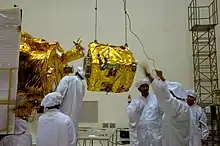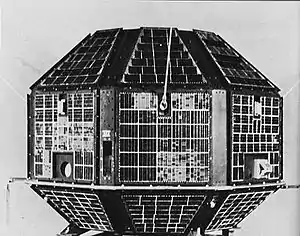Moon Impact Probe
The Moon Impact Probe (MIP) developed by the Indian Space Research Organisation (ISRO), India's national space agency, was a lunar probe that was released by ISRO's Chandrayaan-1 lunar remote sensing orbiter which in turn was launched, on 22 October 2008, aboard a modified version of ISRO's Polar Satellite Launch Vehicle. It discovered the presence of water on the Moon.[1][2]


The Moon Impact Probe separated from the Moon-orbiting Chandrayaan-1 on 14 November 2008, 20:06 and crashed, as planned, out of the lunar south pole after a controlled descent. The MIP struck the Shackleton Crater at 20:31 on 14 November 2008 releasing underground debris that could be analysed by the orbiter for presence of water/ice.[3] With this mission, India became the fourth nation to reach the lunar surface. Other entities to have done so are the former Soviet Union, the United States, and Japan.[4][5]
Kalam's vision
The probe was a product of former President Abdul Kalam's vision who felt that since the Chandrayaan orbiter was already going so near to the Moon, the mission would have more scientific relevance if the probe was included. He believed that the Moon could not be left to a few countries and that India should not be left behind[6] The Times of India also reported a political motive by former president Abdul Kalam as "He believed that if this was done, India "could always stake" a claim to a portion of the Moon."[4] At the same time, The Indian Express reported Kalam as saying "no nation can claim the Moon as its own. The resources of the Moon should be a common property and that is one of the aims of the Moon mission."[7]
Mission objectives
The main objectives of the MIP were to demonstrate the technologies for reaching a specified location on the Moon, qualifying technologies required for any future soft landing missions, and scientific exploration of the Moon from close range just prior to the impact.[8][9]
The probe was designed to collide with the lunar surface and eject underground soil which could then be analysed by instrument on the orbiting Chandrayaan for the presence of water ice, and organic and other materials.[10][11]
Configuration and payloads
The MIP carried three instruments:[12]
- Radar Altimeter – which measured the altitude of the probe during descent and provided information on qualifying technologies for future landing missions. The operating frequency band was 4.3 GHz ± 100 MHz.
- Video Imaging System – acquired close range images of the surface of the Moon during descent and before impact. The video imaging system consisted of an analog CCD camera.
- Mass Spectrometer based payload CHACE – measured trace constituents of the lunar atmosphere during descent. This instrument was a quadrupole mass spectrometer with a mass resolution of 0.5 amu and sensitivities to partial pressures on the order of 1.3×10−11 pascals.
The probe used aluminium sandwich structure onto which the payloads were mounted. The probe attached to the mother spacecraft with a ball lock separation system which jettisoned the unit from the Chandrayaan. A solid propellent de-orbit mortar nudged the craft into lunar orbit, while spin thrusters stabilized the orientation enabling imaging system to capture the descent profile.
The probe's external surface had four oval-shaped anodised aluminium plates measuring 120mm X 180 mm[13] on which the image of the Indian flag was depicted, complete with the Emblem of India and the words "Satyameva Jayate".[13] These plates were attached to each one of the four vertical sides of the probe. As per ISRO specifications these plates had to endure a temperature range from −50 degrees celsius and as high as more than 150 degrees celsius.[13]
Mission chronology
India launched the Chandrayaan-1 spacecraft using a modified version of the PSLV C11[14][15] on 22 October 2008 from Satish Dhawan Space Centre, Sriharikota, Andhra Pradesh at 06:22 IST (00:52 UTC).[16]
The lunar probe separated from Chandrayaaan-1, in a 102 km circular polar orbit around the Moon, at 20:06 IST on 14 November 2008.[3] After separation, it first fired its spin up rockets and then its retro rocket to lower itself to an orbit intersecting the lunar surface.[17] While descending, the MIP continuously sent information back to the Chandrayaan-1 orbiter which in turn beamed the information back to Earth. After a 25-minute controlled descent, it struck the Moon at 20:31 IST, 14 November 2008 at a speed of 1.69 kilometers per second (approximately 6100 km/h or 3800 miles per hour).[17] The crash destroyed the probe. It crashed into Shackleton Crater, at the lunar south pole, 89°S 30°W,[18] at 20:31 on 14 November 2008 releasing underground material that could be analyzed by the orbiter for the presence of water ice.[3]
Discovery of water
On 25 September 2009, ISRO announced that the MIP had discovered water on the Moon just before impact.[1] This announcement was made after the discovery of water was announced on 24 September 2009 by Science magazine by the NASA payload Moon Mineralogy Mapper carried on board Chandrayaan-1.[19] MIP discovered water on the Moon before NASA's Moon Mineralogy Mapper, the announcement of this discovery was not made until NASA confirmed it.[2][20]
This gave the answer to the millennia-old question whether there is water on or in Earth's moon when it led to the discovery of water in its vapour phase by the CHACE (CHandra's Altitudinal Composition Explorer) payload on board the Moon Impact Probe (MIP) and complementarily in its solid phase by the Moon Mineralogy Mapper (M3) payload on board the main orbiter in the Chandrayaan I mission. This ‘discovery-class-of-finding’ by CHACE was achieved by direct in situ measurement of the lunar atmosphere during the descend journey of the MIP to the Lunar South Pole, while M3 discovered water in ice form by remote sensing techniques. As water cannot retain its liquid phase in the lunar environment because of its own vapour pressure and the ultra-high vacuum prevailing there, it can be found in solid (ice) and gaseous (vapour) phases. While the Moon Mineralogy Mapper (M3), a payload by NASA, on board Chandrayaan I lunar orbiter has detected, by mapping almost 97% of the lunar surface using remote sensing techniques, the presence of water in ice form in higher latitudes especially in the polar caps, the CHACE payload in the lunar impactor (MIP) has directly detected water in its gaseous form along 14 degree E meridian from 45 degree N to 90 degree S latitude, with a latitudinal resolution of around 0.10 and altitudinal resolution of ~ 250 m from 98 km altitude till impact .
See also
- Chandrayaan-1
- LCROSS
- List of current and future lunar missions
- Lunar water
- List of artificial objects on the Moon
References
- "MIP detected water on Moon way back in June: ISRO Chairman". The Hindu. Bangalore. 2009-09-25. Retrieved 2013-06-09.
- "Chandrayaan first discovered water on moon, but?". DNA. Bangalore. DNA. 2009-09-25. Retrieved 2013-06-09.
- "Chandrayaan team over the moon". Chennai, India: The Hindu. 2008-11-15.
- Laxman, Srinivas (2008-11-15). "Chandrayaan-I Impact Probe lands on moon". Times Of India. Retrieved 2008-11-14.
- http://news.xinhuanet.com/english/2009-03/01/content_10923205.htm
- "India's Moon Mission". politicalaffairs.com. 2008-10-27. Archived from the original on 2015-10-17. Retrieved 2013-11-06.
- Service, Express News (2008-11-11). "Kalam turns teacher in the midst of students". newindianexpress.com. Archived from the original on 2014-04-12. Retrieved 2014-04-11.
- "Payload bearing Tricolour will land on Moon". The Economic Times. 2008-10-15. Retrieved 2008-10-24.
- "Moon Impact Probe". ISRO. Archived from the original on 2008-10-26. Retrieved 2008-10-24.
- Thomas, Claire (2008-11-05). "Moon craters may hold traces of early life". Cosmos. Archived from the original on 2008-11-08. Retrieved 2008-11-18.
- "Chandrayaan team over the moon". Chennai, India: The Hindu. 2008-11-15.
- "Moon Impact Probe (MIP)". ISRO. Archived from the original on 2008-10-26. Retrieved 2008-10-24.
- "Blore firm behind the Chandrayaan tri-colour". Deccan Herald. 2008-11-16. Retrieved 2008-11-17.
- "Mission Sequence". Indian Space Research Organisation (ISRO). Retrieved 2008-11-05.
- "Chandrayaan-1 shifted to VAB". Chennai, India: The Hindu. 2008-10-22. Retrieved 2008-10-15.
- "PSLV-C11 Successfully Launches Chandrayaan-1". Indian Express. 2008-10-22. Archived from the original on 2008-10-25. Retrieved 2008-10-22.
- "Indian Tricolour lands on Moon". The Indian Express. 2008-11-14. Archived from the original on 2012-10-04. Retrieved 2008-11-14.
- "Frontline India's National Magazine - Moon Mystery - Moon Impact Probe impact coordinates". Archived from the original on 2011-01-10. Retrieved 2011-01-01.
- "Water on the Moon?". Science Magazine. 2009-09-25. Retrieved 2009-09-29.
- Bagla, Pallav (2009-09-25). "Did India beat NASA to find water on moon?". NDTV. Bangalore. Retrieved 2013-06-09.

